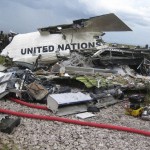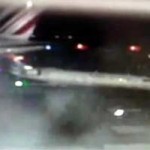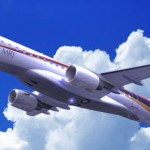On January 31, 2008 at 1721 local time, CRJ 100LR (MSN 7015) operated by Cimber Air of Denmark had an incident during take-off from runway 19L at Oslo Airport Gardermoen (ENGM).
The aircraft was operating as a repositioning flight with two pilots and two cabin crew members on board with its destination as Copenhagen. The aircraft suddenly lost lift on the right wing, causing the wing to drop and sending the aircraft into an uncontrolled 40-degree bank immediately after lift-off. The stall protection system activated, and the crew regained control and continued the flight.
AIBN Norway, the Norwegian flight safety authority released a final report on the accident that indicated the incident occurred because:
The investigation has shown that prescribed de-icing took place 15 minutes prior to departure, and that the wings were not cold-soaked in advance. Weather conditions were temperature at freezing, 15 kt wind and continuous precipitation in the form of aggregated, wet snowflakes. The runway was covered by slush and wet snow which had fallen after the runway had been cleared of snow and sanded 30 minutes earlier. Unintentionally, due to distraction, the system for heating the leading edge of the wing was not switched on prior to take-off. The nose wheel was lifted from the ground at the correct speed, but at a higher than recommended rotation rate.
This incident is one in a number of similar cases. From 2002 to 2008, six CL-600 series aircraft were involved in accidents during winter conditions. The wing of the aircraft type has proven to be especially sensitive to contamination on the leading edge. After the accidents, a number of measures have been implemented to ensure that the wing is clean during take-off, and to ensure that the pilots use the correct take-off technique.
The AIBN believes that the safety measures that have been introduced have not resulted in a definitive solution to the problem. When the de-icing fluid runs off during take-off, it is essential that the leading edge of the wing is heated. On take-off from contaminated runways, spray from the nose wheel will envelop the aircraft’s wing root. This source of contamination hits an aerodynamically critical area on the wing, and comes in addition to the precipitation which can adhere to the wing and disturb the airflow. The AIBN believes that it is not sufficient to depend solely on ”soft” safety barriers such as check lists and memory when the position of one switch (Wing Anti-Ice ON) can be critical to prevent a catastrophic accident during take-off. Technical or physical safety barriers in the form of design changes, automatic systems or automatic warning systems are, in the opinion of the Accident Investigation Board, necessary to obtain adequate reduction in accident risk. Alternatively, more severe restrictions for winter operations with the affected aircraft models must be introduced.
The safety authority made four recommendations as well:
Safety recommendation SL no. 2011/03T
Experience has shown that contaminated wing leading edges on aircraft of the CL-600 series during take-off can cause a premature stall with an uncontrollable wing drop and a risk of a catastrophic outcome. Activation of the Wing Anti-Ice system is considered a crucial barrier to prevent a contaminated wing leading edge. In order to increase the safety margins, the AIBN recommends that Transport Canada and EASA require the type certificate holder (Bombardier) to introduce nonprocedural safety barriers (for instance take-off warning or automatic activation) to ensure that the wing anti-ice system on affected CL-600 series aircraft is activated on take-off in certain winter conditions.
Safety recommendation SL no. 2011/04T
Until satisfactory technical/physical safety barriers have been introduced to ensure that the wing anti-icing system on CL-600 series aircraft is activated on take-off when this is critical to safety (see Safety recommendation 2011/03T above), the AIBN recommends that Transport Canada and EASA impose more severe restrictions on winter operations on the affected aircraft. The restrictions should in effect entail that flying is only permitted if the conditions make it safe to take off without Wing Anti-Ice being activated.
Safety recommendation SL no. 2011/05T
Upon take-off from contaminated runways, the wing root on aircraft of the CL-600 series will be enveloped by spray from the nose wheel. The wing leading edges become contaminated in the area where the airflow first separates when stalling. If the contamination does not vaporise, this area may become rough, which will reduce the stalling angle of the aircraft. The AIBN believes that this aspect has not been sufficiently emphasised and recommends the manufacturer Bombardier to consider the need for solutions which can contribute to diverting the spray away from the wing. An assessment should also be made whether this hazard should be discussed in the aircraft’s documentation.
Safety recommendation SL no. 2011/06T
The investigation has revealed that the Norwegian guidelines for assessing precipitation intensity based on visibility values are less restrictive than more recently published North American guidelines. The guidelines are of importance to how long flight crews can expect de-icing fluid to prevent contamination of the aircraft’s aerodynamic surfaces after de-icing (Hold-Over Time). The AIBN recommends that the Norwegian Meteorological Institute study the research results that form the basis for the new guidelines in the USA and Canada, and any other relevant documentation, and consider whether the Norwegian guidelines should be amended to prevent aircraft from taking off with contamination on the wings.
The full report, in English, can be found at the AIBN Norway website here in PDF format.



